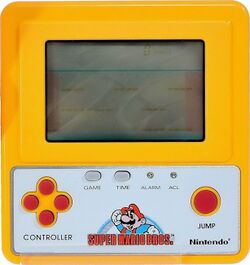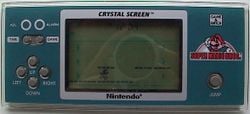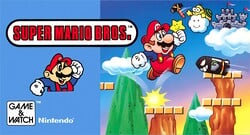Super Mario Bros. (Game & Watch): Difference between revisions
mNo edit summary |
m (→Story) |
||
| (151 intermediate revisions by 59 users not shown) | |||
| Line 1: | Line 1: | ||
{{ | {{italic title}} | ||
{{infobox | {{image|more=yes|visuals from the Crystal Screen and New Wide Screen versions}} | ||
{{distinguish|Game & Watch: Super Mario Bros.|Super Mario Bros. (Nelsonic Game Watch)|Super Mario Bros. Watch|Mario Bros. (Game & Watch)}} | |||
{{game infobox | |||
|image=[[File:mariobrosgandwgame.jpg|250px]]<br>New Wide Screen<br>[[File:SMB G&W YM-901-S.jpg|250px]]<br>Special edition<br>[[File:Super Mario Bros YM-801 Game Front2.jpg|250px]]<br>Crystal Screen | |||
|developer=[[Nintendo Research & Development 1]] | |||
|publisher=[[Nintendo]] | |||
|release={{release|USA|June 25, 1986}} (Crystal Screen)<ref>[https://archive.is/QGNfd Crystal Screen ''Super Mario Bros.'' info page on In the Attic] (Archived via achive.today). Retrieved August 11, 2020</ref><br>{{release|Japan|December 1987}} (special edition)<ref>[https://famicomworld.com/workshop/articles/the-holy-grails/holy-grails-game-watch/ Holy Grails – Game & Watch] Retrieved 20 February 2021</ref><br>{{release|USA|March 8, 1988}} (New Wide Screen)<ref>[http://web.archive.org/web/20220804212506/http://www.intheattic.co.uk:80/super_mario_bros_1.htm Wide Screen ''Super Mario Bros.'' info page on In the Attic] (Internet Archive: Wayback Machine). Retrieved 13 November 2010</ref><br>{{release|Europe|August 6, 1998}} (Mini Classics)<ref>[http://web.archive.org/web/20220412132712/http://www.intheattic.co.uk/mini_classics.htm Mini Classics info page on In the Attic] (Internet Archive: Wayback Machine)</ref> | |||
|genre=[[Genre#Platform games|Platformer]] | |||
|ratings=N/A | |||
|modes=Single player | |||
|platforms=[[Game & Watch]], [[Mini Classics]] | |||
|format={{format|gaw=1}} | |||
|input={{input|gaw=1}} | |||
}} | }} | ||
'''''Super Mario Bros.''''' is a [[Game & Watch]] | [[File:Mario Game & Watch.jpg|thumb|left|250px|Box art for ''Super Mario Bros.'']] | ||
'''''Super Mario Bros.''''' is a [[Game & Watch]] adaptation of the [[Super Mario Bros.|original NES game of the same name]]. It was released in 1986 as the first of the Crystal Screen series, with a transparent screen, weak speakers, and simple character designs compared to later rereleases. [[Mario]], for example, resembles how he appeared in earlier titles such as ''[[Mario's Cement Factory]]''. The next release is the extremely rare version that comes with packaging that looks like [[Family Computer Disk System]]'s mascot Diskun, which was awarded to contestants of the ''[[Famicom Grand Prix: F1 Race]]'' tournament that was held from October 30 to December 15, 1987, in Japan.<ref>[https://pony.velvet.jp/fcdisk/fmcmdskw14.html Disk Fax service data] Retrieved 20 February 2021</ref><ref>[http://www.handheldmuseum.com/Nintendo/SMBPromo.htm The Handheld Games Museum: the "Special" ''Super Mario Bros.''] Retrieved 13 November 2010</ref><ref>[http://web.archive.org/web/20220804212505/http://www.intheattic.co.uk/special.htm In the Attic's page on the "Special" ''Super Mario Bros.''] (Internet Archive: Wayback Machine). Retrieved 13 November 2010</ref> This special edition, of which only 10,000 were ever produced, was the only version available in Japan as [[Nintendo]] had discontinued releasing new Game & Watch titles there after spring 1985. As such, it lacks the Game & Watch branding and its mold differentiates it from all other Game & Watch units. The special edition updates Mario's design to make him more recognizable. In 1988, this game was rereleased as part of the New Wide Screen series, which is actually an older series than the Crystal Screen series. Like the special edition, this version uses the updated character design and has better audio, but lacks the transparent screen. A [[Mini Classics]] version that is essentially the same as the special edition and the New Wide Screen version was released in 1998. | |||
The Crystal Screen version, special edition, and New Wide Screen version of ''Super Mario Bros.'' all have the same gameplay. The overall plot is identical to that of the [[Nintendo Entertainment System|NES]] ''Super Mario Bros.'', but the game itself is completely original, being shorter and simpler. | |||
{{br|left}} | |||
== | ==Story== | ||
[ | '''Story from the instruction booklet:'''<ref>[http://www.intheattic.co.uk/images/G&W/Review/SMB/SMB_YM-105_Page8-9.jpg ''Super Mario Bros.'' manual, page 7]. Retrieved November 25, 2015.</ref> | ||
<blockquote> | |||
Mario, Help! | |||
I am Princess Toadstool of the Mushroom Kingdom. I am in the hands of the Bowser, King of the Koopa. Please rescue me and bring back the peace to the Kingdom of Mushroom. But Mario, you must pass through the dangerous 8 Worlds and face all the ferocious enemy that confronts you. | |||
At the end of each world, an illusion of me will be there to guide you to the next world. However, there are also friends around you. On some of the floors you ride on, there are STARMAN and 1 UP MUSHROOM which I have hidden. These will appear when the floor is punched from the bottom with the JUMP button. The STARMAN makes you invincible for 10 seconds and the 1 UP MUSHROOM gives you 1 extra life. This is the utmost I can offer you Mario, and from here on you must use your own strength. Please save me as soon as you can. | |||
Princess Toadstool | |||
</blockquote> | |||
[[Bowser]] has kidnapped [[Princess Peach|Princess Toadstool]], and Mario is off to save her. At the end of every level, Mario finds the princess without having to fight Bowser or a boss. | |||
==Gameplay== | ==Gameplay== | ||
Mario must go through eight auto-scrolling levels without falling and losing a life. When the levels are cleared, Mario must repeat them in the next loop. The second loops and onward have enemies. Further, [[Lakitu]]s | Mario must go through eight auto-scrolling levels without falling and losing a life. When the levels are cleared, Mario must repeat them in the next loop. The second loops and onward have enemies. Further, [[Lakitu]]s toss a [[hammer]] instead of tossing [[Spiny|Spinies]], and [[Bullet Bill]]s appear randomly. There is a total of nine loops of increasing difficulty. There are two types of levels: scroll screen levels and timer screen levels. On the scroll screen levels, Mario must travel a given distance displayed on the screen. On the timer screen levels, Mario has to go through the world within a given time. Mario can also obtain [[1-Up Mushroom|1 Up Mushroom]]s and [[Super Star|Starmen]] by hitting [[platform]]s, just like in the NES game, at certain places during specific events within the game.<ref>[http://www.replacementdocs.com/download.php?view.2959 Replacement Docs - Super Mario Bros. (Wide Screen)]</ref> | ||
This is one of the few Game & Watch games that do not have a Game B. Unlike the NES game, this game has no multiplayer, possibly due to hardware limitations. | |||
Holding Jump and pressing the Game button starts Mario on L3-1, with 90 distance and enemies enabled. | |||
==Characters== | ==Characters== | ||
* [[Mario]] | *[[Mario]] | ||
* [[Bullet Bill]] | *[[Bowser|The Bowser]] | ||
* [[Lakitu]] | *[[Bullet Bill]] | ||
* [[ | *[[Alarm Koopa]] (Alarm character) | ||
* [[ | *[[Lakitu]] | ||
*[[Fire Bar|Spinning Flame]] | |||
*[[Princess Peach|Princess Toadstool]] | |||
==Levels== | ==Levels== | ||
* World No. 1 Canyon | *World No. 1 Canyon | ||
* World No. 2 Gym | *World No. 2 Gym | ||
* World No. 3 Burning Room | *World No. 3 Burning Room | ||
* World No. 4 Channel | *World No. 4 Channel | ||
* World No. 5 Hop | *World No. 5 Hop | ||
* World No. 6 Beam | *World No. 6 Beam | ||
* World No. 7 Maze | *World No. 7 Maze | ||
* World No. 8 Burning Road | **World No. 7a 3Choice | ||
*World No. 8 Burning Road | |||
==Gallery== | |||
<gallery> | |||
Super Mario Bros. (Game and Watch) - Instruction 1.png|Page 9 of the Crystal Screen version's instruction manual | |||
Super Mario Bros. (Game and Watch) - Instruction 6.png|Image on page 10 of the Crystal Screen version's instruction manual | |||
Super Mario Bros. (Game and Watch) - Instruction 4.png|Image on page 11 of the Crystal Screen version's instruction manual | |||
Super Mario Bros. (Game and Watch) - Instruction 8.png|Image on page 13 of the Crystal Screen version's instruction manual | |||
Super Mario Bros. (Game and Watch) - Instruction 5.png|Image on page 14 of the Crystal Screen version's instruction manual | |||
Super Mario Bros. (Game and Watch) - Instruction 2.png|Image on page 15 of the Crystal Screen version's instruction manual | |||
Super Mario Bros. (Game and Watch) - Instruction 9.png|Image on page 16 of the Crystal Screen version's instruction manual | |||
Super Mario Bros. (Game and Watch) - Instruction 3.png|Image on page 17 of the Crystal Screen version's instruction manual | |||
Super Mario Bros. (Game and Watch) - Instruction 7.png|Image on page 18 of the Crystal Screen version's instruction manual | |||
Keychaingame.jpg|Mini Classics version | |||
SMB G&W Mini Classics Gold Version.png|Gold variant (Mini Classics) | |||
</gallery> | |||
==Names in other languages== | |||
{{foreign names | |||
|Jap=スーパーマリオブラザーズ<ref>[https://www.nintendo.co.jp/hardware/gamewatch/mario/history.html HISTORY|ゲーム&ウオッチ スーパーマリオブラザーズ|任天堂]. ''Nintendo Japan''. Retrieved June 23, 2021.</ref> | |||
|JapR=Sūpā Mario Burazāzu | |||
|JapM=Super Mario Bros. | |||
}} | |||
== | ==Trivia== | ||
* '' | *34 years later, [[Game & Watch: Super Mario Bros.|another Game & Watch version of ''Super Mario Bros.'']] was made. However, this one is a direct port of the NES original. | ||
*Princess Peach's design in the Crystal Screen edition resembles [[Princess Shokora]]'s "young princess" form. | |||
==References== | ==References== | ||
<references/> | <references/> | ||
{{ | {{Super Mario games}} | ||
{{Game & Watch}} | {{Game & Watch}} | ||
[[Category:Game & Watch | [[Category:Super Mario Bros. (Game & Watch)|*]] | ||
[[Category:1986 games]] | |||
[[Category:1987 games]] | [[Category:1987 games]] | ||
[[Category:1988 games]] | [[Category:1988 games]] | ||
[[Category:Games]] | [[Category:Games]] | ||
[[Category:Platforming games]] | |||
[[de:Super Mario Bros. (Game & Watch)]] | |||
[[it:Super Mario Bros. (Game & Watch)]] | |||
Revision as of 09:35, June 16, 2024
It has been requested that more images be uploaded for this article. Remove this notice only after the additional images have been added. Specific(s): visuals from the Crystal Screen and New Wide Screen versions
- Not to be confused with Game & Watch: Super Mario Bros., Super Mario Bros. (Nelsonic Game Watch), Super Mario Bros. Watch, or Mario Bros. (Game & Watch).
| Super Mario Bros. | |
|---|---|
 New Wide Screen  Special edition  Crystal Screen | |
| Developer | Nintendo Research & Development 1 |
| Publisher | Nintendo |
| Platform(s) | Game & Watch, Mini Classics |
| Release date | Template:Release (Crystal Screen)[1] Template:Release (special edition)[2] Template:Release (New Wide Screen)[3] Template:Release (Mini Classics)[4] |
| Genre | Platformer |
| Rating(s) | N/A |
| Mode(s) | Single player |
| Format | Game & Watch:
Built-in
|
| Input | Game & Watch:
|
Super Mario Bros. is a Game & Watch adaptation of the original NES game of the same name. It was released in 1986 as the first of the Crystal Screen series, with a transparent screen, weak speakers, and simple character designs compared to later rereleases. Mario, for example, resembles how he appeared in earlier titles such as Mario's Cement Factory. The next release is the extremely rare version that comes with packaging that looks like Family Computer Disk System's mascot Diskun, which was awarded to contestants of the Famicom Grand Prix: F1 Race tournament that was held from October 30 to December 15, 1987, in Japan.[5][6][7] This special edition, of which only 10,000 were ever produced, was the only version available in Japan as Nintendo had discontinued releasing new Game & Watch titles there after spring 1985. As such, it lacks the Game & Watch branding and its mold differentiates it from all other Game & Watch units. The special edition updates Mario's design to make him more recognizable. In 1988, this game was rereleased as part of the New Wide Screen series, which is actually an older series than the Crystal Screen series. Like the special edition, this version uses the updated character design and has better audio, but lacks the transparent screen. A Mini Classics version that is essentially the same as the special edition and the New Wide Screen version was released in 1998.
The Crystal Screen version, special edition, and New Wide Screen version of Super Mario Bros. all have the same gameplay. The overall plot is identical to that of the NES Super Mario Bros., but the game itself is completely original, being shorter and simpler.
Story
Story from the instruction booklet:[8]
Mario, Help!
I am Princess Toadstool of the Mushroom Kingdom. I am in the hands of the Bowser, King of the Koopa. Please rescue me and bring back the peace to the Kingdom of Mushroom. But Mario, you must pass through the dangerous 8 Worlds and face all the ferocious enemy that confronts you.
At the end of each world, an illusion of me will be there to guide you to the next world. However, there are also friends around you. On some of the floors you ride on, there are STARMAN and 1 UP MUSHROOM which I have hidden. These will appear when the floor is punched from the bottom with the JUMP button. The STARMAN makes you invincible for 10 seconds and the 1 UP MUSHROOM gives you 1 extra life. This is the utmost I can offer you Mario, and from here on you must use your own strength. Please save me as soon as you can.
Princess Toadstool
Bowser has kidnapped Princess Toadstool, and Mario is off to save her. At the end of every level, Mario finds the princess without having to fight Bowser or a boss.
Gameplay
Mario must go through eight auto-scrolling levels without falling and losing a life. When the levels are cleared, Mario must repeat them in the next loop. The second loops and onward have enemies. Further, Lakitus toss a hammer instead of tossing Spinies, and Bullet Bills appear randomly. There is a total of nine loops of increasing difficulty. There are two types of levels: scroll screen levels and timer screen levels. On the scroll screen levels, Mario must travel a given distance displayed on the screen. On the timer screen levels, Mario has to go through the world within a given time. Mario can also obtain 1 Up Mushrooms and Starmen by hitting platforms, just like in the NES game, at certain places during specific events within the game.[9]
This is one of the few Game & Watch games that do not have a Game B. Unlike the NES game, this game has no multiplayer, possibly due to hardware limitations.
Holding Jump and pressing the Game button starts Mario on L3-1, with 90 distance and enemies enabled.
Characters
- Mario
- The Bowser
- Bullet Bill
- Alarm Koopa (Alarm character)
- Lakitu
- Spinning Flame
- Princess Toadstool
Levels
- World No. 1 Canyon
- World No. 2 Gym
- World No. 3 Burning Room
- World No. 4 Channel
- World No. 5 Hop
- World No. 6 Beam
- World No. 7 Maze
- World No. 7a 3Choice
- World No. 8 Burning Road
Gallery
Names in other languages
| Language | Name | Meaning | Notes |
|---|---|---|---|
| Japanese | スーパーマリオブラザーズ[10] Sūpā Mario Burazāzu |
Super Mario Bros. |
Trivia
- 34 years later, another Game & Watch version of Super Mario Bros. was made. However, this one is a direct port of the NES original.
- Princess Peach's design in the Crystal Screen edition resembles Princess Shokora's "young princess" form.
References
- ^ Crystal Screen Super Mario Bros. info page on In the Attic (Archived via achive.today). Retrieved August 11, 2020
- ^ Holy Grails – Game & Watch Retrieved 20 February 2021
- ^ Wide Screen Super Mario Bros. info page on In the Attic (Internet Archive: Wayback Machine). Retrieved 13 November 2010
- ^ Mini Classics info page on In the Attic (Internet Archive: Wayback Machine)
- ^ Disk Fax service data Retrieved 20 February 2021
- ^ The Handheld Games Museum: the "Special" Super Mario Bros. Retrieved 13 November 2010
- ^ In the Attic's page on the "Special" Super Mario Bros. (Internet Archive: Wayback Machine). Retrieved 13 November 2010
- ^ Super Mario Bros. manual, page 7. Retrieved November 25, 2015.
- ^ Replacement Docs - Super Mario Bros. (Wide Screen)
- ^ HISTORY|ゲーム&ウオッチ スーパーマリオブラザーズ|任天堂. Nintendo Japan. Retrieved June 23, 2021.
| Game & Watch games | ||
|---|---|---|
| Super Mario franchise | Donkey Kong (1982, MS) • Mario Bros. (1983, MS) • Mario's Cement Factory (1983, TT/NWS) • Mario's Bombs Away (1983, PS) • Donkey Kong Hockey (1984, MVS) • Super Mario Bros. (1986, CrS | 1987, Sp | 1988, NWS) • Mario the Juggler (1991, NWS) • Game & Watch: Super Mario Bros. (2020, CoS) | |
| Donkey Kong franchise | Donkey Kong (1982, MS) • Donkey Kong Jr. (1982, NWS | 1983, TT & PS) • Donkey Kong II (1983, MS) • Donkey Kong 3 (1984, MVS) • Donkey Kong Circus (1984, PS) • Donkey Kong Hockey (1984, MVS) | |
| Miscellaneous | Green House (1982, MS) | |
| MS: Multi Screen • TT: Table Top • PS: Panorama Screen • NWS: New Wide Screen • MVS: Micro VS. System • CrS: Crystal Screen • Sp: Special • CoS: Color Screen | ||











